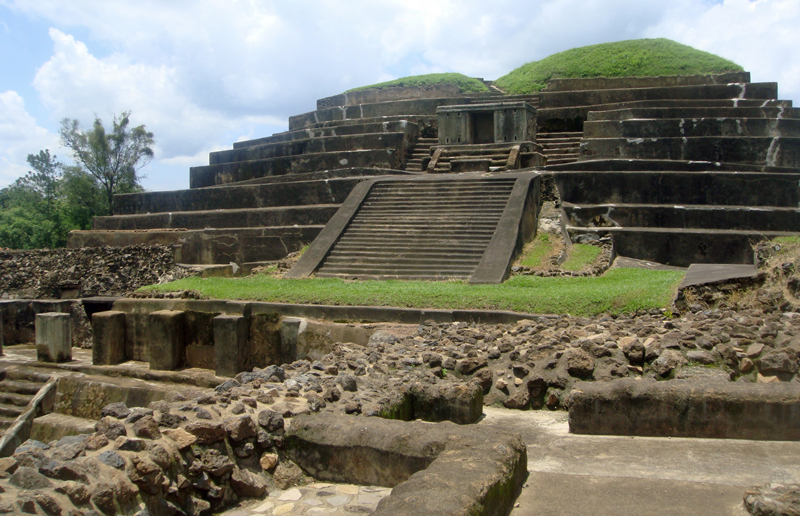Scientists have sifted through the aftermath of an enormous volcanic eruption that rocked Central America a millennium and a half ago.
By meticulously cataloguing volcanic debris spewed across El Salvador, researchers have reconstructed the dynamics of the Tierra Blanca Joven (TBJ) eruption, as well as its impact on nearby Maya civilization. They showed that the eruption of the Ilopango caldera occurred in eight distinct phases, one of which blanketed the landscape in a layer of rock and ash roughly 70 meters thick, and that the tallest volcanic plume towered 49 kilometers into the atmosphere.
These results, published in June in the Journal of Volcanology and Geothermal Research, suggest that Maya settlements in the area were significantly affected by the eruption.
Dario Pedrazzi, a geologist at the Institute of Earth Sciences Jaume Almera of the Spanish Scientific Research Council in Barcelona, led the fieldwork for the study. In 2015 and 2016, Pedrazzi and his colleagues traveled to El Salvador three times to look for evidence of the TBJ eruption. This event, which the new paper’s authors date between roughly 270 and 535 CE, takes its name (meaning “young white earth”) from the white, acidic ash (tephra) it left behind.
Classical Stratigraphy
Working across roughly 20,000 square kilometers of El Salvador, Pedrazzi and his collaborators searched for exposed rock walls that might harbor evidence of the eruption. These rock walls were associated with, for example, road construction, quarries, and archaeological digs. The researchers focused on over 80 of these outcroppings that contained layers of tephra and larger pieces of rock known as lapilli.
“It’s classical stratigraphy,” said Pedrazzi. “We describe all of the different layers that we see in the field.” The researchers also collected samples from the layers to analyze back in the laboratory.
Confirming previous work, the scientists found eight layers (units) corresponding to different phases of the eruption, which likely lasted from a few days to a few weeks in total. The units included fallout debris and debris entrained in pyroclastic density currents. The latter—high-temperature mixtures of gases, lapilli, and tephra—had ripped down the sides of the caldera to distances of up to 40 kilometers, the team estimated.
Pedrazzi and his colleagues analyzed the size distribution of the ash and lapilli using sieves with meshes ranging in size from 0.25 to 64 millimeters. They also studied material by passing it through a particle analyzer that bounced laser beams off the particles to determine their dimensions.
Pedrazzi and his colleagues found that the units ranged in thickness from a few centimeters to roughly 70 meters. Unsurprisingly, the largest debris, rocks measuring about a meter in size, was closest to the caldera. Fine-grained ash, on the other hand, was dispersed over 100 kilometers from the eruption site, the team showed. Other teams have found deposits from the TBJ eruption in Guatemala, Honduras, Nicaragua, Costa Rica, and the Pacific Ocean.
This eruption is one for the history books, said Robert Dull, a paleoecologist at the University of Texas at Austin who was not involved in the research. “It’s potentially 1 of the 10 largest eruptions on the planet during the Holocene.”
To the Top of the Stratosphere
Pedrazzi and his colleagues used software to reconstruct the TBJ eruption. They based their calculations on the varying thicknesses of volcanic products at different distances from the caldera.
They estimated that the tallest plume from the TBJ eruption, associated with the last unit, reached nearly 50 kilometers into the atmosphere. At that height, roughly the top of the stratosphere, the volcanic ash would have been entrained by air currents and transported far distances. These high-altitude air currents “allowed the material to fly around the world,” said Pedrazzi.
Other researchers have suggested that aerosols from this eruption might have remained lofted in the atmosphere for years, resulting in a temporary cooling of the planet that was recorded in the 6th century.
Pedrazzi and his colleagues also estimated how much magma erupted from Ilopango caldera during the TBJ event: roughly 30 cubic kilometers, about 120 times as much as the 1980 eruption of Mount St. Helens in Washington.
“It was a big eruption,” said Pedrazzi, who describes it as being larger than the 1991 eruption of Mount Pinatubo in the Philippines but smaller than the 1815 eruption of Tambora in Indonesia.
Displacement of Maya Communities
The TBJ eruption likely had widespread repercussions for local communities.
People living within 50 to 60 kilometers of the caldera were either killed or forced to move elsewhere when fallen ash and rock made farming impossible, Pedrazzi said.
Maya settlements, which dotted the region at the time, would have been among those displaced. In addition to forced relocation of those in the vicinity of the eruption, Maya construction projects and trade routes in the area were likely shut down.

“The magnitude of this eruption means that Mayan populations living in the region would have been considerably affected,” the researchers wrote.
This thorough analysis of the dynamics and progress of the TBJ eruption “helps to bring the eruption to life and to really understand what the Maya were experiencing,” said Dull. “This was a massive natural catastrophe that had huge implications for Maya cultural evolution.”
A similar eruption today would be catastrophic, the researchers note: 3 million people currently live within 30 kilometers of the caldera. San Salvador, the capital of El Salvador, is fewer than 10 kilometers away. In fact, most of the San Salvador metropolitan area is built on tephra deposits from the TBJ eruption.
Pedrazzi and his colleagues aren’t finished with the Ilopango caldera yet. They’re now studying its eruptive history, looking as far back as 1.5 million years. The scientists want to understand the return period of eruptions and whether these events are clustered in time.
This work has “hazards implications in El Salvador and neighboring countries,” said Pedrazzi.
—Katherine Kornei (@katherinekornei), Freelance Science Journalist






